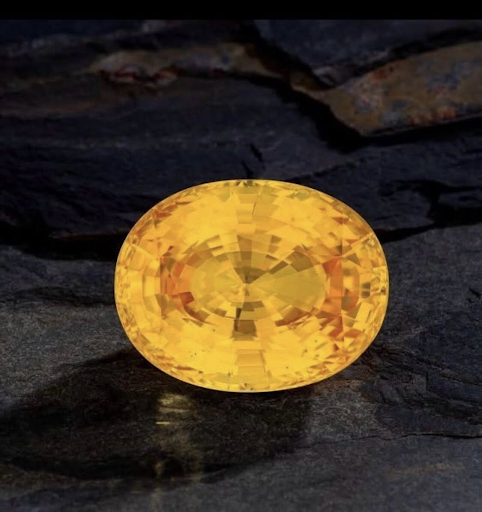If you’ve got a soft spot for brilliant, golden gems (and let’s be honest—who doesn’t?), yellow sapphire is probably already on your radar. With its sunny glow, cosmic lore, and geological intrigue, it’s a favorite among collectors and jewel lovers alike. But beyond the bling, there’s a fascinating story behind this vibrant gemstone.
What is Yellow Sapphire?
Yellow sapphire is a variety of corundum, the same mineral family as ruby and blue sapphire. What gives it that golden sparkle? Iron. Trace amounts of iron in the crystal structure create hues ranging from soft lemon to deep orangey-gold. You’ll even find greenish yellows and golden tones that seem like bottled sunlight. But the ultimate collector’s dream? A medium, vibrant canary yellow—striking, saturated, and glowing with warmth.
 |
| Louis Vuitton - 50.01 carat Exceptional ‘Golden’ yellow sapphire |
With a hardness of 9 on the Mohs scale, yellow sapphire is tough enough for daily wear. So whether you’re into rings, pendants, or simply curating a mineral cabinet that makes your geologist friends jealous, this stone’s got you covered.
Where Does It Come From?
 |
| Jeff Mason Photography - "The Sunrise of Ceylon" 115 carat yellow sapphire from Sri Lanka |
The story of yellow sapphire starts in Sri Lanka, home to some of the world’s oldest and most respected sapphire mines. These gems were originally found in alluvial deposits and igneous rocks, where iron-rich conditions laid the foundation for their iconic color. Ancient traders valued these stones not only for their beauty but also for their supposed celestial powers.
 |
| Jacob & Co - Limited Edition Caviar Tourbillions baguette yellow sapphires |
And while Sri Lanka remains the primary source today, yellow sapphires also come from Tanzania, Madagascar, Thailand, and Australia. Each region produces stones with subtle variations in hue, size, and clarity—making collecting them all a bit like catching Pokémon (but shinier).
Natural vs. Treated: Why It Matters
Most yellow sapphires on the market are heat-treated. This enhances their color and clarity—essentially giving nature a little boost. While there’s nothing wrong with a heated gem, serious collectors and purists will tell you: the real prize is an untreated stone. Unheated yellow sapphires, especially those with vibrant color and excellent clarity, are increasingly rare—and priced accordingly.
 |
| Louis Vuitton - 30.47 carat Ceylon yellow sapphire necklace |
If you're shopping around, always ask for certification if a seller claims a stone is unheated. Lab reports don’t lie.
Why Collect Yellow Sapphires?
Apart from their obvious aesthetic appeal, yellow sapphires have a rich metaphysical and cultural history. In Vedic astrology, they’re associated with the planet Jupiter—symbolizing knowledge, wisdom, and prosperity. Believers say they bring good fortune and financial growth. Skeptical? That’s cool. They still look amazing under a display light.
 |
| Louis Vuitton - “Vision Necklace” yellow gold, platinum, yellow sapphire and diamond necklace |
Yellow sapphire is more than just a “pretty yellow stone.” It’s a gem with ancient roots, scientific charm, and spiritual allure. Whether you're in it for the sparkle, the symbolism, or the geology, it’s a gem worth getting to know—and maybe even obsessing over.
So next time you spot that glowing, canary-hued crystal in a case or catalog, take a closer look. You might just be looking at the crown jewel of your collection.
